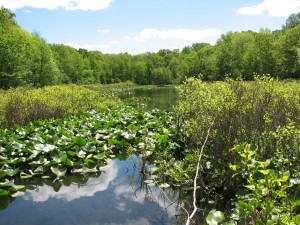The Tenafly Nature Center has been preserving nature and exposing residents to its beauty since 1961. Over the years, the Center has been largely dependent upon grants, local supporters, and educational programming to fund its annual budget.
The Visitor’s Center, also known as the John A. Redfield Building, is home to a small natural history museum, the Stephen Minkoff Memorial Natural History Library, TNC staff, educational materials and park amenities. The 2014 there was an initial proposal from the board’s trustees to build a new facility that would be called the Educational and Discovery Center. This new building would be much larger, play host to indoor educational programming year round, and be more visible to residents and visitors alike.
But in a 2014 public referendum the voters spoke, and the borough of Tenafly would not be getting a new visitor’s facility at the Tenafly Nature Center. The small, 400-acre, not-for-profit nature facility has been fundraising for the last few years in hopes of rebuilding the 50 year old visitor’s center and adding more functionality, along with code upgrades. The trustees were able to raise upwards of $700,000 for the project, much of that from large donors, before all plans were brought to a halt after that referendum.
The group spent almost $697,000 on the proposed center before it was shut down by local voters. The expenses included architectural drawings, permits, surveys of the proposed building site, and a consultant to help with the fundraising. Anthony Martin, the treasurer for the Tenafly Nature Center’s board stated that most of the expenses were covered with donations from trustees themselves. Other large supporters of the planned project were released from their pledged donations, according to Peter Punzi, the TNC’s executive director.
The original proposal was to build a $7 million visitor’s center, increasing the programming capabilities, bringing it up to code by making it handicap accessible, and enlarging the parking area. The new building was to have classrooms and educational areas for year-round educational programming, birthday parties, and/or community events. The proposed building was to be located on East Clinton Road, a highly trafficked thoroughfare. This would not only bring more recognition to the center from local travelers, but it would also allow them to continue with programming in the current structure during the new construction. It would also preserve a large amount of the rock and wooded area from being damaged or removed from the current site.
An opposing group, Save Tenafly Green Acres, was adamant about not building along east Clinton, stating that it would indeed damage part of the 400-acre forest it was intended to preserve. The opposition and potential controversy prompted the Borough Council to hold a public referendum in 2014 with regard to the proposal, and that is when the project was publicly voted down.
With the fundraising having taken place, research and logistics plans in line, and moneys already spent, the trustees were dealt a blow they were not ready for when the proposal was voted down. Deflated and awestruck, the board and its trustees were no doubt disappointed.
The board’s treasurer and former president, Anthony Martin stated, “Certainly we will ultimately do some renovations and sprucing up, but we won’t look to build a bigger facility.” Instead of physical growth, Martin stated that there were other ways to be great at what they do, and that they “want to develop a more distinctive program for students in primary grades” and that they will “have to come up with more creative ways to use the facility [they] already have.”
With no new facility plans in the near future, another underlying issue the Tenafly Nature Center board faces has to deal with future fundraising efforts. Having spent so much time building trust and gaining momentum with the fundraising effort for this project, and then having the doors closed so suddenly, the fear is that these large contributors will not be as supportive in the future when a need arises. The current, much smaller-scaled plan calls for trail upgrades and accessibility, and although there are grants and government funds to assist, it is likely that they will need to fundraise, but will the support be there? Only time will tell.


 English
English Chinese
Chinese Korean
Korean Hebrew
Hebrew Russian
Russian